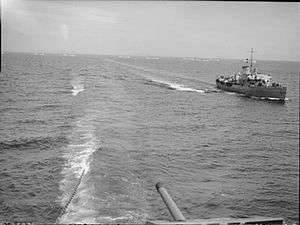HMS Rhododendron (K78)
 HMS Rhododendron during refueling trials at sea | |
| History | |
|---|---|
| Name: | HMS Rhododendron |
| Ordered: | 19 September 1939 |
| Builder: | Harland and Wolff Ltd., Belfast, Northern Ireland |
| Laid down: | 22 May 1940 |
| Launched: | 2 September 1940 |
| Commissioned: | 18 October 1940 |
| Out of service: | 17 May 1947 – placed in reserve |
| Identification: | Pennant number: K78 |
| Fate: | sold 1950; scrapped 1968 |
| General characteristics | |
| Class and type: | Flower-class corvette (original) |
| Displacement: | 925 long tons (940 t; 1,036 short tons) |
| Length: | 205 ft (62.48 m)o/a |
| Beam: | 33 ft (10.06 m) |
| Draught: | 11.5 ft (3.51 m) |
| Propulsion: |
|
| Speed: | 16 knots (29.6 km/h) |
| Range: | 3,500 nautical miles (6,482 km) at 12 knots (22.2 km/h) |
| Complement: | 85 |
| Sensors and processing systems: |
|
| Armament: |
|
HMS Rhododendron was a Flower-class corvette that served with the Royal Navy during the Second World War. She served as an ocean escort in the Battle of the Atlantic.[1][2]
Background
The ship was ordered on 19 September 1939 from Harland and Wolff in Belfast, Northern Ireland. The ship's keel was laid on 22 May 1940,[3] and the ship was launched on 2 September. The ship was commissioned about one month later, on 18 October.[4]
War Service
On 21 November 1940, Rhododendron attacked the German U-Boat U-103 with depth charges. Although U-103 escaped unscathed, this attack led to the incorrect claim that Rhododendron had sunk U-104. That same day, she picked up 36 survivors from the merchant ship Daydawn, which earlier that day had been sank by U-103. On 17 January 17, 1941, she detonated a mine in Liverpool harbor. This resulted in her being out of service for three months. On 28 July 1941, she picked up 26 survivors from the Lapland, a merchant which was torpedoed by U-203. On 4 July 1943, she picked up more than 300 survivors from several merchant ships which were torpedoed by German submarines U-409 and U-375 off of Algeria.
Fate
She was sold in 1950 to a shipping company, where she was turned into the merchant Maj Finke. She was sold for demolition in South Africa in 1968.
Sources
- Gardiner, Robert (1987). Conway's All the World's Fighting Ships 1922-1946. London: Conway Maritime Press. ISBN 0-85177-146-7.
- Preston, Antony; Raven, Alan (1982). Flower Class Corvettes. London: Arms and Armour Press. ISBN 0-85368-559-2.
- Lynch, John (2012). Belfast Built Ships. Stroud, UK: The History Press. ISBN 978-075246-539-5.
- Friedman, Norman (2008). British Destroyers & Frigates - The Second World War and After. Barnsley, UK: Seaforth Publishing. ISBN 978-1-84832-015-4.
References
- ↑ "HMS Rhododendron, British corvette, WW2". www.naval-history.net. Retrieved 2017-03-07.
- ↑ "HMS Rhododendron (K 78) of the Royal Navy - British Corvette of the Flower class - Allied Warships of WWII - uboat.net". uboat.net. Retrieved 2017-03-07.
- ↑ Lynch, p. 98
- ↑ Friedman, p. 340